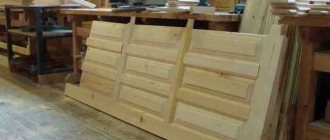Frame making
First of all, it is necessary to make a frame on which the slats will be attached. For good fastening, it is recommended to use a material thicker than wooden planks, for example, 20x45 mm timber. If this is not possible, then the slats themselves can be the frame. The main thing is fastening; at this stage problems arise.
Fastenings in the frame can be made in different ways:
- Cut at 45 degrees and fix with nails (the simplest, but unreliable option).
- Connection in a tenon, in a fringe, “dovetail” and the like (reliable, but difficult to implement).
Attaching the slats to the frame
Since we are considering the simplest method, we will use nails. The slats are installed at an angle to the frame with the same step between them (the photo shows a step of 10 cm), then they are nailed to the frame on both sides, and the remaining wood is cut off.
Measuring distances Fastening slats with nails Fastening in corners Mounting slats
The first method is to make a lattice and attach it to the gazebo
The simplest option is to use wooden slats, which are nailed to the frame, after which the entire structure is attached to the gazebo. The finished grid looks like this:
Frame making
First of all, it is necessary to make a frame on which the slats will be attached. For good fastening, it is recommended to use a material thicker than wooden planks, for example, 20x45 mm timber. If this is not possible, then the slats themselves can be the frame. The main thing is fastening; at this stage problems arise.
Fastenings in the frame can be made in different ways:
- Cut at 45 degrees and fix with nails (the simplest, but unreliable option).
- Connection in a tenon, in a fringe, “dovetail” and the like (reliable, but difficult to implement).
After making the first frame, you will need to make another one. It is installed on top of the constructed grille on the reverse side to hide all the cut corners of the slats.
Attaching the slats to the frame
Since we are considering the simplest method, we will use nails. The slats are installed at an angle to the frame with the same step between them (the photo shows a step of 10 cm), then they are nailed to the frame on both sides, and the remaining wood is cut off.
Garden trellis
It has a simpler design and is distinguished, above all, by its strength. As a rule, these are firmly planted posts made of concrete, metal or wood. A wire or strong rope is stretched horizontally between them.
If the trellis is installed permanently for a long period, then the horizontal slats can be made of metal rods. The height of the structure depends on the length of the plant and ease of use.
Features and Benefits
A summerhouse can be constructed from various materials: wood, metal, brick or decorative stone. Regardless of this, decorative wooden grilles will always look harmonious on it. Usually they are inserted into shallow free openings on the side walls, secured in rectangular frames, but they may not fill the entire wall, made in the form of a fence or carved insert elements under the roof.
The most common examples of such gratings for street buildings
in the form of inclined slats arranged crosswise to each other. They are very easy to make, requiring a minimum of tools and cheap materials. But there are also more labor-intensive projects with carved patterns, real works of art. Made from high-quality dried wood and securely fastened, such decorative elements can last for decades in a summer cottage, even in unfavorable weather conditions.
The advantages of homemade wooden gratings for gazebos are:
- ease of manufacture, low cost of material;
- aesthetic value - the appearance in front of a country house will immediately noticeably change for the better;
- there will always be shade and coolness inside the gazebo;
- versatility for any type of gazebo design;
- since the walls are not solid, there will always be an influx of fresh air inside;
- if food is prepared in the gazebo, or a stove, grill or barbecue is installed, the smoke will quickly disappear.
To create truly reliable and durable decorative elements for a future gazebo, you need to choose the right source material.
General recommendations
Where to start making a pergola?
Select an option
To master the construction of a pergola with your own hands, first of all you need to look at different design options:
- it can be in the form of a canopy, attached to the house or as a separate structure (like a gazebo);
- the roof can be made in a traditional style (square or rectangular), gabled, arched, sloped or as a promenade structure;
- the pergola itself can be built in the Japanese style or in the form of a rotunda; some people like corner options (one of the easiest to build with your own hands);
- You can also choose different style solutions: country, high-tech, modern, oriental, chalet, half-timbered, etc.
You also need to decide on the material. Everything will depend on your skills and finances. Stone and forged structures are one of the most fashionable, sought-after and beautiful options. However, they are mostly made to order by professionals. If you are not a mason or a blacksmith, it is better not to take on such complex structures. The best option is wood. It is easy to process, looks rich, and allows you to add some of your own flair to the building. Metal is more difficult to work with.
Pergolas:
Related article: Pergolas in landscape design
Preparation
The next step is selecting a scheme. Here a lot depends on your skills and abilities. If you have worked with wood or metal before, if this is not your first experience in construction, assembling a pergola with your own hands will not be difficult. Some people won't even need step-by-step instructions. But beginners should still find a detailed algorithm of actions.
When you finally have what you want in your head, calculate how much material you will need, what tools and fasteners you will need to use. Always take an order of magnitude more. As practice shows, it’s better to have extra left over than to go shopping several times to look for something.
A general list of tools that may be useful for constructing a wooden pergola:
- hand drill;
- drill and wood bit;
- pencil/marker;
- paint brushes;
- hammer;
- fine-grained sandpaper / sander;
- hand saw for wood / jigsaw;
- plumb line;
- roulette;
- chisel;
- clamps;
- square;
- building level;
- screwdriver
Tools for building a metal pergola:
- welding machine;
- Bulgarian;
- building level;
- roulette;
- square;
- pencil/marker;
- shovel;
- galvanized wire.
Selecting a location
Tips from landscape designers for placing a gazebo in the garden:
- a pergola in the middle of the site does not look good - it is better to choose a place on the edge;
- An excellent option for a small garden would be an extension to the house in the form of a canopy;
- those who want to build a full-fledged gazebo with a barbecue and a table with their own hands can choose a corner near a wall or fence, in the shade of large trees;
- it can be an arch to design the transition from one zone of the site to another (along a path or alley);
- if the site already has climbing plants that lack support, it would be logical to erect a supporting structure next to them;
- You may need to create shading over a parking lot or playground - in which case a pergola will also be an excellent solution to the problem.
Try to plan for mostly sunny weather during the work. Always keep in mind the risk of rain in order to protect the material from it (store under a canopy or cover with a water-repellent film).
Basic methods of grating assembly
There are two main types of how to make a decorative sheathing for a gazebo:
How to make a grill for a gazebo
- overlaying planks on top of each other;
- assembly of planks using grooves.
First way
Using the first method will significantly save time spent on work. This is primarily due to the fact that the technology for installing the planks is much simpler, however, it does not look as impressive.
At an angle, in two layers
The essence of this method is that the planks are installed at an angle crosswise in two layers:
- in one of them, the slats are laid parallel to each other at a certain distance;
- another row is laid on top at such an angle that symmetrical crosshairs are formed.
Second way
The second method looks much more impressive, however, it requires more time and skill level.
Method with grooves
This method involves installing all the planks at one level; this is achieved using grooves that are made in the planks at the places where they intersect.
Types and features
It is not at all difficult to assemble the frame, sheathe it and install the roof. But decorating the gazebo tastefully is the next question.
One of the most affordable and simplest solutions is to use a wooden lattice. It will serve as both a fence and an element of decoration. It seems like a simple element, but the gazebo will take on an aesthetic and elegant look. Moreover, it is not difficult to make it on your own and at your own discretion.
First you need to decide on the choice of material, and then use your imagination and creative imagination.
Openwork lattice parapets look light, give grace to the entire structure, and do not block the light. Therefore, they can encircle the perimeter of the gazebo.
It consists of the following elements: two frames rigidly hold the entire structure, with inserts of crossed slats between them.
By combining planks and shaping shapes in different ways, you can create types of wooden gratings:
- open and closed view;
- with intersecting slats;
- with connection in grooves.
Metal
If you want to install a metal pergola, it is better to make it from profiled pipes with a rectangular cross-section or fittings.
Choice
Metal pergolas are quite varied in their design. So it’s worth starting with a choice:
- hinged, arched, semi-arched, gallery;
- dynamic and static;
- single-row and multi-row;
- decorated with forged elements and as simple as possible in decoration.
You should choose a model not only taking into account its beauty and functionality, but also from the point of view of the ease of its installation, because everything will have to be done with your own hands.
Sketch
The construction of a metal pergola begins with a sketch. It requires much greater precision than when constructing a wooden one. It’s easy to saw the wood, remove the excess, make another notch or fill up the unnecessary one. It's difficult to do all this with metal.
Selection of material and tools
To make your own decorative wooden lattice for a gazebo, you don’t need much. You need a wooden beam and a batten, which can be purchased at any construction market, as well as a minimum set of carpentry tools:
- Hammer.
- Axe.
- Set of chisels.
- Saw on wood.
- Electric drill.
- A set of screwdrivers or a screwdriver (if available).
- Metal ruler or tape measure.
- Clamp.
- Plane.
- Wort.
It is necessary to equip the workplace with a workbench, which is easy to make if necessary. Working while standing is much more convenient and productive.
Even a beginner can make a simple workbench with a tabletop made of a sheet of thick plywood.
Note. The timber and slats for the grating must be made of dry wood and free from large knots and cracks; they must have the same dimensions.
Briefly about the main thing
A decorative wooden lattice for a gazebo covers the interior space from prying eyes, decorates it, and protects it from direct sunlight. It’s not difficult to make it yourself if you have the necessary materials.
Different types of wood have characteristic properties, texture, and colors. You can, without resorting to dyes, use wood of the desired color to create an original gazebo decor. And if you try to create a complex pattern, you will get a unique creation.
Source
Material selection
The material for creating such gratings has its own specific requirements. It should be beautiful, well protected from moisture, temperature changes and sunlight. Since in most cases thin slats are used for sheathing, strength is the determining factor.
Oak is good because it bends well with the required strength.
The expressive structure with pleasant shades of this wood is known to everyone. Oak wood is easy to process, excellently polished and painted, and due to the high concentration of tannins in the composition, it is less susceptible to rotting. Bog oak with a noble black color can look simply gorgeous on a summer cottage.
Beech is also durable and relatively easy to process and bend. The texture of the wood has a yellowish-red tint with well-defined annual rings. Parts made from this wood are widely used for the manufacture of outdoor structures, including decorative elements of gazebos.
Ash slats can have a yellowish-brown or red color with pleasant textures. This wood is dense and viscous; when dry, it bends well and does not crack or warp. In addition, ash practically does not rot.
Birch parts for the manufacture of decorative grilles are a good choice, due to the fact that this wood is very easy to cut, sand and drill, and its strength indicators are excellent. To prevent the material from rotting, it must be treated with an antiseptic and coated with varnish or transparent paint. It is most successful to choose Karelian birch for decoration with a pleasant and expressive texture.
Aspen sheathing will have a pleasant reddish tint. The advantage of this type of wood is that it has virtually no knots, this simplifies the processing process, and the cross-sectional appearance will be more beautiful. This material dries quickly, polishes and paints well.
You can choose other types of wood that have useful properties and beautiful texture:
alder, linden, pine, cedar. If handled correctly, they will all be strong and durable. Actually, it’s not even so important what kind of wood is chosen, you can take any available one, the main thing is to carry out all the carpentry work carefully and reliably. Reviews say that oak and beech are the most popular when making grilles for gazebos.
Types of trellises
The trellis design creates many advantages for plants:
- growing shoots are distributed at even distances, which allows sunlight to penetrate;
- good ripening of shoots occurs and the yield increases, its taste improves;
- during the cold period it is easier to provide shelter;
- agricultural plants can be maintained mechanically, as well as harvesting.
Select an option
To roughly understand how to make a decorative lattice for a gazebo yourself, you need to decide on a specific model that will be discussed in the article.
Decorative lattice for a 3 by 3 gazebo
As an example, let's take a simple square gazebo measuring 3 by 3 meters and cover it with a lattice, leaving only a doorway. The height of the walls will be 2.5 meters. The doorway will measure 2 by 1 meter.
The option used will be a square single-level lattice with grooves. This method results in a more attractive structure that will delight the owners of their personal plot.
This is what the finished model will look like
The cell will be located at an angle of 90 degrees relative to the walls and floor, i.e. will be square. The size of all cells will be 300 mm. This option will allow you to avoid high costs for the purchase of lumber, and will also reduce the amount of time spent on its manufacture.
What can you build a pergola from?
Pergolas are made from different materials. It is important to consider not only the desired appearance and functionality of the structure, but also the expected service life. Supports are usually made of logs, beams, or several boards fastened together. You can make the sheathing from a picket fence.
Wood is sensitive to moisture, so you should choose the most rot-resistant species - oak, larch, pine. Willow is suitable for a canopy.
The service life of a structure largely depends on the hardness of the wood used. For aesthetics and increased resistance to adverse conditions, a decorative coating should be made. Stain, varnish, and paint are suitable for this. Resistance to moisture and decay will be enhanced by treatment with special antiseptics.
Wood can be combined with other materials to increase the strength of a structure or reduce construction costs. It is good to use metal pipes as supports.
Location
Different ways of stuffing strips will lead to drawings:
- in the shape of rectangles;
- in the shape of a diagonal.
A very beautiful pattern is obtained by crossing narrow planks. The impression can be increased by cutting out different patterns: in the form of teeth or waves . Their implementation along the edges of the lattice strips creates an excellent design.
If it is not possible to make patterns due to the lack of suitable tools, you can order them from a carpenter. You can buy ready-made patterns in the store.
The second option is to install slats in the gazebo window
If in the first version the grille was made in advance, then in this case the slats are immediately attached to the window at an angle of 45 degrees.
Idea for a gazebo with trellises
Before sheathing the gazebo, it is necessary to calculate the length of the material. The most difficult thing here is the calculations - you need to clearly measure the dimensions so that the distances in the cells are the same and the whole “picture” looks symmetrical.
The grille is attached to self-tapping screws at an angle of 45 degrees to the window, after which the slats themselves are also fastened together. Gaps at joints can be hidden with decorative plinths.
This option is suitable if the gazebo has smooth windows, which will allow you to attach wooden blocks to it without additional processing.
The video above shows step-by-step instructions on how to implement this option. This video is not as dynamic as the next one (although the method is more professional), but it shows the essence and understanding of the method very well.
Installation
Installing the sheathing on the gazebo is monotonous, but not difficult. First of all, you need to get everything you need.
Materials and tools
The list is not very long, but it is mandatory:
Reiki. The dimensions depend on which part you are going to sheath and on the dimensions of the gazebo itself. For example, if you have a two-meter high wall and a solid finish, then you should purchase three-meter products. Thickness and width are at your discretion, but preferably no thicker than one centimeter, preferably about five millimeters.
Example of suitable slats
Advice: it is better to take in excess of the number of slats. Because it is unknown how much will be spoiled and transferred as a result of pruning.
- Nails or screws.
- Hammer or screwdriver, depending on the chosen fastening method.
- Electric jigsaw or hand saw for cutting.
Jigsaw
Tape measure, pencil and spirit level for marking and level control.
Work progress
For example, let’s take the cladding of a solid wall of a building.
The following instructions will help you do everything correctly:
- Along the perimeter of the wall on the vertical and horizontal piles of the frame we apply marks every 15 cm. This step determines the size of the cells; you can use any other according to your preference.
Drawing of sheathing a solid wall
- We start from the upper left corner. We measure the distance between the first marks from it on the horizontal and vertical beam.
- We measure the resulting segment on the bar and cut it using an electric jigsaw. In this case, we make the edges at 45 degrees for greater aesthetics. For greater precision, you can use a clamp.
Sample of a trimmed product
- We nail or screw the rail diagonally at the measured location.
- We check its evenness with a spirit level. In our case it will be 45 degrees, but you can make diamond-shaped patterns and then the angle of inclination will be different accordingly.
- Next, measure the distance between the next marks, which will be larger, and similarly cut and fix the bar.
Tip: in the case of covering an equilateral surface, for convenience, you can cut two products to the same dimensions at once, since the counter strips will have similar lengths, and this will simplify your work.
- So we fill the entire plane with parallel slats, regularly checking the correctness of the angle of inclination, otherwise the slightest deviation will then be noticeable during visual inspection.
- After complete filling, we move to the upper right corner, measure the distance between the marks closest to it on the piles, cut off the strip and mount it perpendicular to the previous ones.
The resulting ornament
- We cover the wall to the end and enjoy the result of the work done.
In addition to the classic arrangement, you can choose one of those shown in the following figure:
Lathing options
Types of partitions
The most common type of decorative partitions of this type is a mesh of interwoven thin slats mounted on a wooden frame. There may be several options for manufacturing the main frame. It should fit exactly into the side opening; you can make it with your own hands from beams, for example, with a section of 20 by 40 mm.
To make the rectangular structure rigid and durable, the sides are best secured with a tenon joint.
“at the expense”, “at half a tree”, “at the end” or “thorn nest”, you need to choose depending on your capabilities and skill. Some people make a frame from old furniture or door frames, the advantage is that there is already a ready-made tenon joint.
The lathing of the decorative opening inside the frame is made with thin slats of the same thickness. You can use components with a cross section of 5x10, 10x20 mm or others. They are nailed or screwed with self-tapping screws to the frame along its sides or at an inclined angle at the same distance, crosswise. The easiest way is when one row of slats is superimposed on another, perpendicular to the first.
Another way to connect elements on the sheathing is “hidden”
, when the slats do not overlap, but seem to be recessed into each other. To do this, grooves are made at the joints half the depth of the rail and its thickness. The notches can be made by hand using a hacksaw or chisel.
This method is quite painstaking and significantly increases the assembly time of the gazebo, but as a result you can get a neat-looking solid lattice, and in addition, its strength increases.
The partition may not be assembled from individual slats, but made from a single sheet of plywood, chipboard, laminated board or board. To create a lattice, openwork patterns are cut into them; the result can be a chic carved lattice. The advantages of this method are strength, no need for assembly, originality of the pattern, but the weight of the structure can be significantly greater than that assembled from slats.
A simple solution
The simplest pergola for beginners is a roof in the form of crossbars (on which ivy or vines grow) supported by 4 beams.
Let's take a step-by-step look at how to build it yourself.
What you will need
Pine is good for constructing a pergola, as it is the most inexpensive type of wood. However, it must be well dried, otherwise the structure will then move, and it is extremely difficult to level it. The table shows building materials, sizes and quantities.
Preparatory stage
1. Using a jigsaw, cut the edges of the beams - timber (those indicated in the table in the amount of 9 pieces and with a cross-section of 100x100x3000 mm).
2. On the remaining beam, which will go under the racks, make recesses for the longitudinal floor beams:
- fold 4 beams together;
- align in height;
- fasten with clamps;
- make markings: from the edge - 90 mm;
- recess depth - 25 mm;
- make multiple cuts with a hacksaw from the cutting line to the edge;
- knock down the partitions with a hammer;
- process the recesses with a chisel.
Make notches on both sides of the beams.
Toner treatment
Toner is a paint specially designed for wooden buildings. It has a lot of advantages:
- tints (you can choose any shade);
- preserves the natural texture of wood;
- does not require applying a fixing layer of varnish;
- gives the material such practical properties as hydrophobicity and ultraviolet resistance;
- protects against external negative influences.
Therefore, instead of regular paint, purchase toner and treat the prepared timber with it in 2 layers - this will be enough for a reliable, durable coating. Algorithm of actions:
- Sand the details.
- Protonate them in one layer.
- Wait until completely dry.
- Protonate a second time.
- Wait until it dries completely a second time.
Another undeniable advantage of the toner is that after 2-3 years, when the need for repainting arises, you will not need to peel off the exfoliated pieces. All you need to do is go through the sander and retonate (only 1 time).
Marking on the ground
1. Using pegs and rope, mark the area where the pergola will stand. Dimensions - 2.6 by 3 m.
2. Make holes for the supports (with a shovel or drill). Depth - 1 m.
3. Place the beams in the holes so that the cuts run along the long sides of the markings. Make sure they are at the same height.
4. Fill the holes with cement mortar. Let it harden.
Installation
1. Mount longitudinal beams (those 4 m long) on recesses. Leave the edges to protrude 40 cm beyond the posts.
2. Drill through holes with an electric drill (they are needed for the bolts holding the beams and the rack together).
3. Secure the structural parts with bolts and nuts.
4. Place crossbars evenly along the top of the longitudinal beams, securing them with clamps and securing them with self-tapping screws.
Inside you can put a table with chairs and flower pots. Plant climbing plants along the ceiling and counters - virgin grapes, garden ivy, golden hops or tropical dicentra. This design option can be draped with airy translucent fabrics.
Fast, simple and convenient
Using the described method, decorative elements for a gazebo with a simple design are made.
In the process of working on a product, successful ideas often come up, the implementation of which allows you to diversify the design.
Lattice is a simple but popular way to decorate gazebos. Trellis bring comfort and homeliness to the recreation area, and their production does not require special skills and does not take much time.
The third option is a “groove-to-groove” grille
This method is professional; it will be impossible to implement it without a hand router and a circular saw. If you have access to woodworking tools, then you can approach the issue professionally and execute this option.
The entire process is presented in the video below (with professional voice acting). Sergei Neiman showed his own conductor, which will help you implement such sheathing with your own hands.
Making planks
To make the planks, we need a fairly thick board, in which grooves are cut using a hand router.
The finished board with grooves is sawn on a circular saw. The result is identical slats, which will later become the gratings in the gazebo.
Fastening the strips
Unlike previous versions, glue is used here to attach the planks to each other. Initially, the entire structure is assembled “groove to groove” at an angle of 45 degrees, then each plank is pulled out, after which glue is applied and then glued. The work is monotonous, but the result is excellent.
After attaching the planks to each other, a frame is made, which is attached to the sheathing. The finished sheathing is varnished, after which it can be used to decorate the gazebo.
With a bench
An excellent option for a summer cottage is a miniature pergola-gazebo with a bench for those who do not like noisy companies. It is ideal both for supporting climbing plants and for comfortable resting. The arched design allows for a thick ivy curtain to be placed at the top. And rose bushes or clematis growing along the side of the sheathing will make the building romantic and attractive.
Materials
Note: * - with allowance.
In addition to what is listed in the table:
- countersunk screws;
- brass nails for frames (16 and 20 mm);
- clear varnish for exterior use.
Recommended material is cedar.
Blueprints
Step-by-step instruction
Arch:
- Cut out blanks A and B (arch and stand).
- Saw off the ends at A.
- Mill grooves along the upper ends of B and the sawn arches.
- On a workbench, pull the top segments together.
- Glue them together.
- Make markings.
- Make allowances, cut out the upper parts, and clean to the desired contours.
- Glue the pillars and arches.
- Clean the arches and tighten them with clamps.
- Drill holes (4 mm) in the top.
- Round the edges.
What's next:
- Cut out spacers C, D and E.
- Glue E to D.
- Drill holes at the ends D (2.4 mm).
- Use screws to secure spacers C and D between A and B.
Bench:
- Cut out element G for the back.
- Cut out the backs and supports.
- Connect three supports F and G with glue. Tighten with clamps.
- Cut out I and H. Bevel edge I.
- Round the edges.
- Attach the jumpers to the supports with screws.
- Cut out the strips for J.
- Round the leading edge.
- Attach the slats to the seat (6 mm apart).
- Secure the seat between the arches using screws.
Side grilles:
- Make elements K and L.
- Fasten together.
- Secure between the posts.
- Sand all external elements.
- Cover with varnish.
A mini-pergola with a bench only at first glance seems like a simple design, but in fact only an experienced carpenter can make it.
Installing a wooden lattice in the gazebo opening
The easiest way to install a grill for a gazebo is this: a small beam is driven into the opening with nails or screws, to which the grill is attached.
Installing the support beam and grille
More experienced craftsmen install wooden grilles without fastening beams directly into the opening, which requires a certain skill and accuracy.
An example of installing a wooden lattice in a gazebo directly into the opening
Advice. Decorative wooden grilles for the gazebo, framed by timber, are installed at some distance from the opening, which visually increases the openwork effect of the product.
An example of installing a lattice in a frame between the gazebo posts
Preparatory stages
First of all, draw a drawing of the lattice. To do this, measure the required height and width in advance, or determine them based on the drawing of the gazebo itself. After this, mark whether the top and bottom sections will be straight or curly.
Select a pattern and calculate the desired cell pitch. To better imagine the result, you can lay out several slats in front of you. If necessary, adjust their pitch, making it tighter or wider, and finally measure the resulting distance.
Mark the type and pitch of the sheathing on the drawing and calculate the required amount of material.
Don't forget about the tool
Prepare your tools. To make the grating you will need:
- knife or chisel;
- hacksaw with fine teeth;
- hammer;
- forceps;
- nails or screws;
- square;
- roulette;
- antiseptic;
- varnish;
- wood glue.
For sheathing, slats with a cross section of 1x2 cm and beams of 2x4.5 cm are often used, but you can choose them at your discretion.
How to decorate a lattice?
That’s why they are called decorative grilles - they should not only be reliable, but also attractive in appearance. The easiest and fastest way to plant a climbing and necessarily lush tree next to the structure. Since summer in our country is relatively short, it is advisable to use fast-growing and easy-to-care vines. For example, actinidia, climbing rose, virgin grapes, ivy and hops. In spring, water from the roof should not pour onto the plant, otherwise it will not survive.
We also recommend reading
For added impact, the wooden trellis for your pergola can be painted in a color that best matches the plant. You will definitely guess if you take black, bronze, or a shade of “rust” as a basis.
Pink roses and bright yellow flowers look interesting against the background of a blue lattice of wood. Flowers of light shades are good on a dark background, dark red shades are good on a light background.
In conclusion, we want to give you this advice. When planting girlish grapes, pay special attention to fastening. The plant is absolutely undemanding in care, which is why it can grow even larger than necessary. With the onset of autumn and the ripening of the berries, the lattice becomes so heavy that it can simply break.
Instead of output
A decorative lattice allows you to inexpensively and quickly close the gazebo with your own hands and plant cute vines around the base. Ultimately, this will protect you from the bright sun in the summer, and in the cold autumn it will weaken the gusts of wind. How to make a wooden structure as reliable as possible? The wood is coated with impregnation in several layers. Instead, you can use varnish - it is no less effective.
When an open-type gazebo has a self-made gazebo frame, its appearance is instantly transformed. Perhaps this is the most luxurious design option, which gives the garden building incredible lightness and delicacy.
To say that wooden gratings for a garden gazebo with your own hands are in great demand is to say nothing. They can be seen almost everywhere. The suburban building takes on an impressive and presentable appearance, and manufacturing does not pose any particular difficulties even for a beginner. Perseverance and hard work can bring their own “zest” to landscape design. You want to be proud of your gazebo, right?











